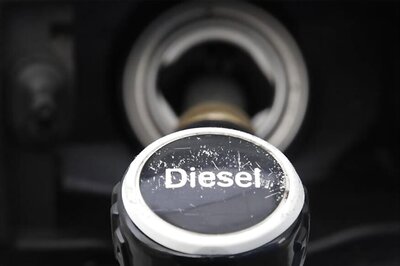
views
New York: Frustration grew for superstorm Sandy's victims in the U.S. Northeast on Friday, many of whom were left with no power, no gasoline and little information about when their shattered lives might return to normal.
While Manhattan prepared to host the annual New York City Marathon on Sunday, acute gasoline shortages in the city's storm-battered outer boroughs and New Jersey led to long lines and short tempers.
Tankers finally began entering New York Harbor on Thursday, and a tanker carrying 2 million barrels of gasoline arrived at 2 a.m. (0600 GMT) on Friday, New York Governor Andrew Cuomo said.
Sandy, which brought a record storm surge to coastal areas, killed at least 102 people after slamming into the U.S. Northeast on Monday. Forty-one died in New York City, about half of them in Staten Island, which was overrun by a wall of water.
Starting before dawn on Friday, long lines of cars snaked around gasoline stations around the area in scenes reminiscent of the energy shortage of the 1970s.
"The police are stopping people who are trying to cut in the line," said Steven Golub, 53, an attorney who waited in line for hours at a Manhattan gas station. "There's no gas anywhere else. There was a guy with diplomatic plates who tried to cut in the line and one of the cab drivers complained so the police actually stopped him."
Police were in place at many spots to keep the peace between furious, frustrated drivers. In one instance, a man who attempted to cut in line was charged with threatening another driver with a gun on Thursday in the borough of Queens.
"When people cut the line, people are about to stone them," said Chris Allegretta, who had stood in line for 90 minutes with a gas can at a filling station in Hasbrouck Heights, New Jersey.
Less than 40 percent of all gas stations in New York City, Long Island and New Jersey operated on Thursday because of a combination of power outages and constricted supplies after the storm devastated the energy industry's ability to move fuel into and around the New York City region.
U.S. Secretary of Homeland Security Janet Napolitano and Federal Emergency Management Agency Deputy Administrator Richard Serino planned to visit Staten Island on Friday amid angry claims by some survivors that the borough had been ignored.
President Barack Obama, locked in a tight race with Republican challenger Mitt Romney, has so far received praise for his handling of storm relief. But scenes of angry storm victims could affect the U.S. political campaign with Election Day four days away.
"They forgot about us," said Theresa Connor, 42, describing her Staten Island neighborhood as having been "annihilated." "And Bloomberg said New York is fine. The marathon is on," she said, referring to Mayor Michael Bloomberg.
Rising seawater flooded lower Manhattan, much of which still lacked power and subway service on Friday, while midtown and uptown Manhattan were close to normal.
Fury has been escalating throughout New York at Bloomberg's decision to proceed with the marathon on Sunday, vowing the event - which attracts more than 40,000 runners - would not divert any resources storm victims.
"I just walked past four huge generators. Those could be put to use for people who need them," said Marjorie Dial, a tourist from Oregon who was shocked to see the generators in Central Park, where the marathon finishes. "What they've discovered on Staten Island should have been the tipping point - the bodies."
New York City Councilman James Oddo said on his Twitter account: "If they take one first responder from Staten Island to cover this marathon, I will scream."
More than 3.7 million homes and businesses along the U.S. East Coast remained without power on Friday.
While power was expected to be returned throughout Manhattan by Saturday, it could be another week or more in suburbs and more distant towns along the coast.
Cuomo directed the New York National Guard to deploy an additional 600 troops to help restore the grid in Westchester and Rockland counties, suburbs north of New York City.
Forecasts for colder temperatures only added to the tension, since many in New Jersey and elsewhere have been using fuel-powered generators to run lights and heaters while waiting for utilities to repair downed power lines.
Disaster modeling company Eqecat estimated Sandy caused up to $20 billion in insured losses and $50 billion in economic losses, double its previous forecast. New York Comptroller Thomas DiNapoli estimated economic losses of $15 billion to $18 billion in New York state alone.
At the high end of the range, Sandy would rank as the fourth costliest U.S. catastrophe, according to the Insurance Information Institute, behind Hurricane Katrina in 2005, the September 11, 2001, attacks and Hurricane Andrew in 1992.
Sandy started as a late-season hurricane in the Caribbean, where it killed 69 people, before smashing ashore in the United States with 80-mile-per-hour (130-kph) winds. It stretched from the Carolinas to Connecticut and was the largest storm by area to hit the United States in decades.















Comments
0 comment